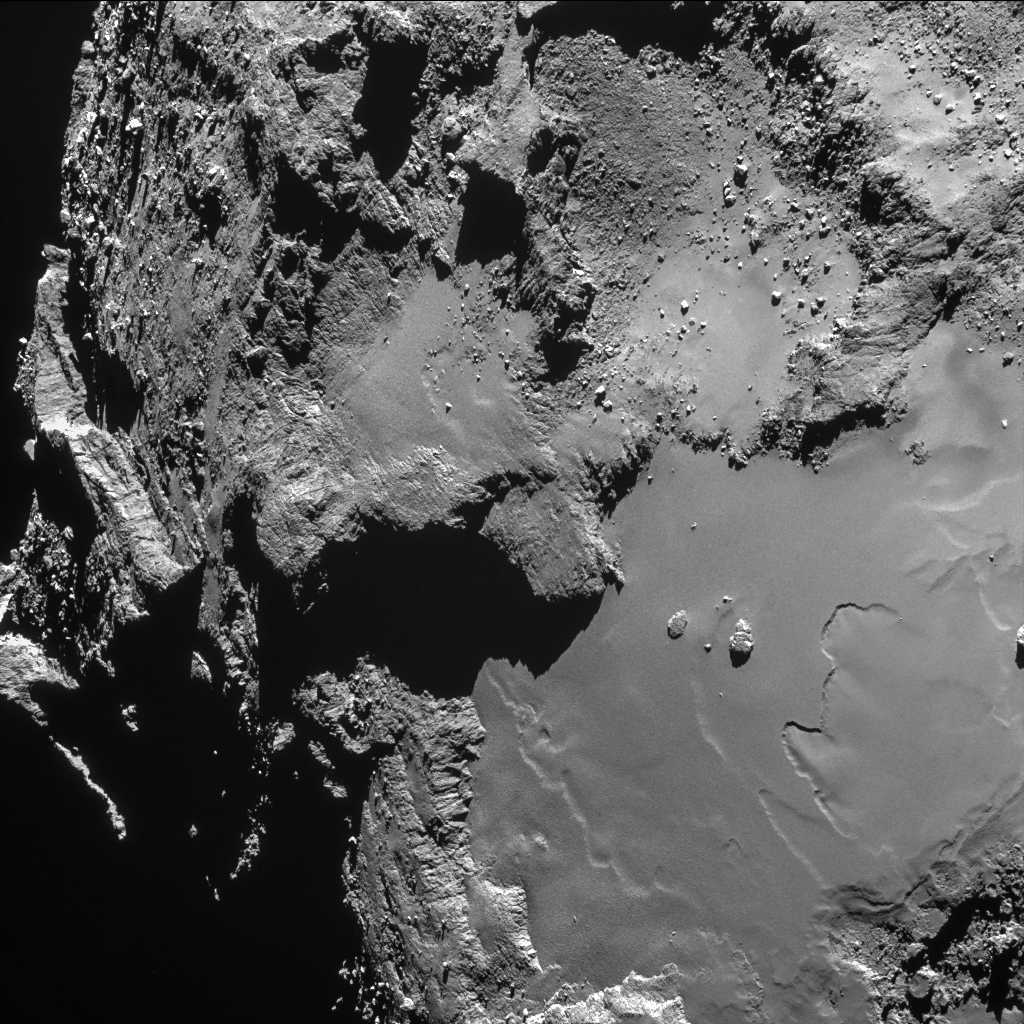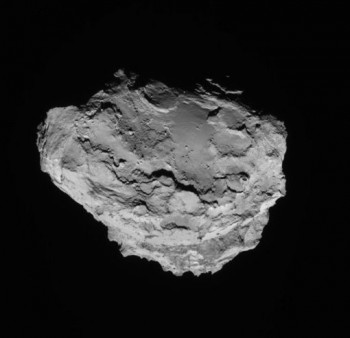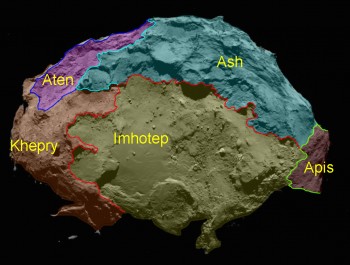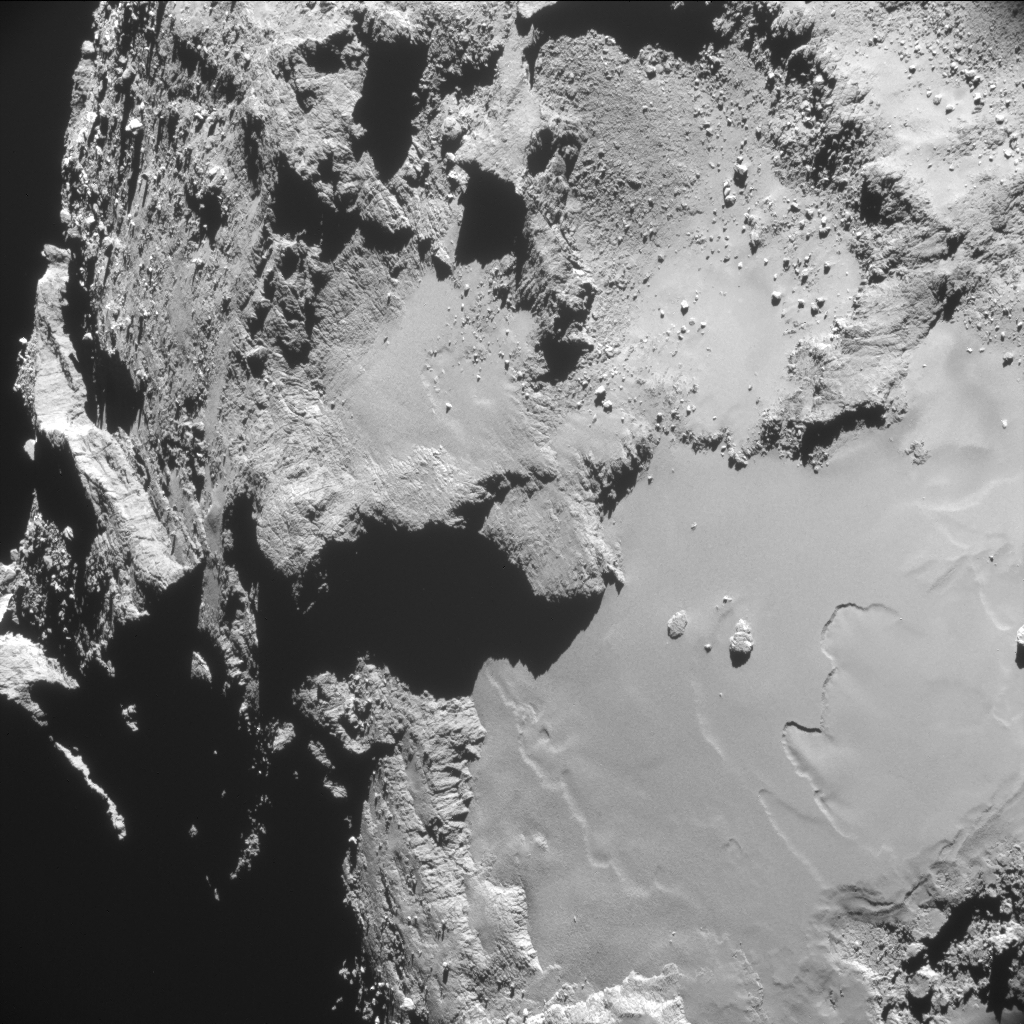In today’s CometWatch post, we not only present a previously unseen NAVCAM image from the close flyby on 14 February, but we also reflect on some of the challenges encountered in operating in this new environment.
The image below is a single frame (1024 x 1024 pixel) NAVCAM image taken at 16:12 UT on 14 February, from a distance of about 15.3 km from the surface. The image scale is 1.3 m/pixel and the frame measures 1.3 km across. The image was taken over the Imhotep region on Comet 67P/C-G’s large lobe (see the supporting images below for context).
Compare it to the frame taken at 14:19 UT to see much of the same region at a different viewing angle, as the comet rotated and spacecraft moved during the two hours between the images.

Single frame NAVCAM image taken at 16:12 UT on 14 February. The image has been lightly processed to remove vignetting and to increase the local contrast. Credits: ESA/Rosetta/NAVCAM – CC BY-SA IGO 3.0
The data acquired during Rosetta’s close flyby will provide incredible new details of the comet’s surface and near coma environment, complementing that collected earlier in the mission while on bound orbits.

Imhotep in context. This wider field view (captured on 15 August from 91 km) shows the Imhotep region on the comet’s large lobe.
Credits: ESA/Rosetta/NAVCAM – CC BY-SA IGO 3.0
For the close flyby, Rosetta had to move away from the terminator (the division between day and night) and towards the sunlit side of the comet. (Check this video to get an idea of the trajectory.) This provided a good opportunity to perform unique science: the illuminated side is the most active, and the geometry was such that the spacecraft passed through the point where the Sun was directly behind Rosetta, allowing the reflection properties of the surface to be determined.
But flying closer to the surface means flying through denser regions of outflowing gas and dust, which results in the spacecraft and its large solar arrays being exposed to significantly more ‘drag’.
In general, Rosetta’s solar panels are oriented perpendicular to the Sun, to capture the most sunlight. Usually, terminator orbits are preferred, with the solar panels edge-on to the outflowing material to minimise the drag. But in this flyby geometry, the flat face of the solar panels was oriented more or less parallel to the comet’s surface and thus perpendicular to the outflowing material, maximising the drag. Imagine holding your hand under a stream of water – it’s like the difference between the relative ease at moving your hand through the stream edge on, thumb or little finger first, compared to doing it palm first.

Annotated map of the ‘underside’ of the comet’s large lobe, showing the Imhotep region. Rosetta passed over this region at a distance of just 6 km during the 14 February flyby. Credit: ESA/Rosetta/MPS for OSIRIS Team MPS/UPD/LAM/IAA/SSO/INTA/UPM/DASP/IDA
However, for the 14 February event, it seems that flying this close to the comet also had another effect: the spacecraft effectively couldn’t see the usual number of “signposts” for navigation, namely stars.
The operations team report that already two hours before closest approach, the spacecraft began to lose the ability to identify enough stars to track correctly, and occasionally locked onto “false” stars – a result of the comet’s coma environment. This resulted in the spacecraft switching to some backup units (including its backup star tracker) in order to try and address the issue. However, the backup also subsequently experienced tracking problems due to the lack of stars in the field-of-view during the flyby.
“With a lot of luck, the spacecraft did not end up in ‘safe mode’,” says Sylvain Lodiot, Rosetta spacecraft operations manager. “Although in this case we could have recovered the spacecraft and resumed operations as planned, the science instruments would have automatically switched off in the meantime. By the time they had been switched back on, we would have been relatively far away from the comet again.”
“Doing science during a close flyby like this is not easy, and we are looking at ways to better prepare for future flybys so that we can maximise science while not jeopardising the safety of the spacecraft,” adds Matt Taylor, ESA’s Rosetta project scientist.
Indeed, the team are discussing plans to fly through one of the comet’s jets this summer, taking into account the lessons learned from this first close flyby.
The original 1024 x 1024 pixel frame from today’s entry is provided below:










Discussion: 35 comments
Spectacular Rosetta images of Comet 67P/C-G. Very jagged and loosely strewn surface features.
Thank you for both the picture and the story!
I guess at its age, Rosetta is not well equipped to be able to navigate using surface features of the comet core instead of distant stars. But perhaps it might be good idea for future cometary missions, should there be any?
I also hope you did not get too much dirt on solar panels during the pass. At first I wondered why is Rosetta making the pass at such great speed but now with all the extra info the reasons became clear.
I can maybe add a “fun” fact about those StarTrackers. In 2003, I was part of an engineering team covering launch and transfer to the geostationnary orbit of a telecom spacecraft.
This spacecraft was the first of its kind to rely on StarTrackers to correctly position and orientate itself during maneuvers (first of its kind for the space company I was working for).
Basically, a StarTracker is a camera, looking at the star field and comparing it to the ones stored into its memory. If I remember correctly it takes 7 “good” stars, i.e recognized, to validate the orientation.
The spacecraft I was working on was embarking other instruments to backup StarTrackers since it was a first.
Here comes the fun fact: at the end of the transfer orbit, when we approached the geostationnary orbit, the StarTrackers started having issues. They kept switching from nominal to redundant: there was a problem between what they observed and the maps they had in memory. Quick investigations showed that the other spacecrafts already in geostationnary orbits were reflecting light and disturbing the StarTrackers imagery.
Once in position, the problem disappeared since the StarTrackers were aiming at a part of the sky not including the geostationnary belt.
The ‘Soap Opera’ programing mindset. Common among young programmers. They code extensive blocks for very few ‘composite’ scenarios, instead of coding short blocks for a lot of ‘modularized’ scenarios.
Happy they had a bit of good luck that it succeeded without any safe mode then.
An observation is that parallel ridge like features, as seen in the left part of this new NAVCAM image frame, seems to be a popular feature in the transition between the currently lit northern part of the comet and the dark southern part Although as always with the same boring disclaimer that it might not be true and that I’m simply being fooled by the light and shadows. Something to be especially cautious of due to these features being close to the terminator. Whatever is behind the “ridges” is being obscured by dark shadows even if they aren’t much lower than the top of the “ridge”. So essentially this is a rather baseless observation.
which date is correct for the recording?
02/14/15 16:12 GMT on 18 February or 2015?
Best Regards
Gertrud
Sorry,
to read in this link.
https://www.esa.int/spaceinimages/Images/2015/02/14_February_close_flyby_16_12_GMT
Best Regards
Gertrud
Hi Gertrud; the date of the flyby was 14 Feb. Date in the caption at the link above has been corrected. Thanks and apologies for any confusion.
Nice image Emily, thanks. We have seen this region of the comet from multiple angles, distances and different phase angles. This experience means I am reluctant to pick out any but the gross details. The next view always seems to refute observations from the previous one.
The huge cliff at the edge of the Khepry region, top left, is the most striking feature of this image. Unlike nearly all the other surfaces, cliffs and layers, there is very little fracturing, suggesting it is a fairy recent feature. The area in front of it seems to have sunk quite dramatically, possibly to fill some large subsurface void. Opposite across the depression the surface seems remarkably level, though covered in lots of randomly sized and spaced rubble. It looks as if it has been scraped clean as if the layers of material on top of it have slid off towards the Imhotep basin. It certainly indicates a clear discontinuity.
The layering of material in this region at the bottom of the image has been discussed before, but looking at this image how much is due to linear fracturing of the cometary material? With the removal of some of the dust from these formations, we see that they are criss crossed with grooves and fracture planes, the vast majority being linear. To me this suggests a crystalline material.
In contrast at the top of the image, the material is crumbly, disordered and dominated by rubble and non linear features, rounded and wavy edges. This material appears more igneous in nature as if it has undergone a change from semi-molten to solid, contracted, cracked and crumbled into rubble. In other words a more volcanic looking landscape as opposed to the sedimentary type nature of the area the other side of the basin.
One for the planetary geologists to unravel that one. The Amorphous Ice/Crystalline ice phase change theory could explain it nicely, but I still need convincing that is actually viable. Lab experiments by NASA are one thing, but wildly different conditions and material INSIDE a comet, are another.
Agree with Robin,. “This experience means I am reluctant to pick out any but the gross details.” Especially of OSIRIS. Been unable to build memory from their photos.
That’s an interesting article. The part where the star-trackers lost their targets and had difficulties to re-target them at all raised my attention. This fact should have been known before, isn’t it? I mean if you “skim” that close to the surface and the NAVCAMs have no chance of catching why not enable this “safe mode” manually and leaving the science instruments on? What would be the risk if the navigation is overridden for a few hours?
“Safe mode” means a state when the craft stops doing anything and waits for commands from Earth. It is used when it gets into a state that’s too far from expected that it has no (better) instructions what to do. In general, getting into safe mode is very undesirable but having it as fallback plan saved quite a few missions.
It would be nice to see a recent photo of 67P from earth, but an internet search comes up negative…I
I did not realize the flyby was this risky. Congratulations on coming through, and all the best as the comet becomes more and more active.
I’ve painted the comet, lander and Rosetta on a mural in a school playground in Battersea London
That’s amazing Brian Barnes! Spark those little minds 🙂
An irreplaceable experience, isn’t it!! Is the flyby in the summer in discussion going through that famous jet from the neck??
Close call! Trough this endeavor, came to the idea of ‘fluffy’, slowly departing snow/particulate.
Cryo-volcanism is ‘hitting hard’ that.
Also freeze-dry mud and superficial high pressure fracturing are feasible. [Remember those candies cracking on the mouth?].
Guessing University Teams are thinking of re-design their experiments for higher extrapolations.
A very strange image indeed! It shows fault lines which appear as cliffs and escarpments in the upper left quadrant continue into the lower right as fainter lines in the smoother terrain.
Looking from the lower left corner up and to the right there is an obvious lengthening of the distance between the fault lines – it looks logarithmic to me.
What on 67P can be causing that?
Andy F
I think I can explain the phenomenon you are describing. I don’t think they are fault lines in the sense that they are fissures or crevices as such. I believe they are the end-on manifestation of successive strata layers. In that sense we are seeing fracture planes between the strata so yes, they are faults in a manner of speaking.
Their manifestation is to do with a large amount of material being removed from the Imhotep plain in such a way that it’s been excavated like a rectangular wooden bowl. The grain of the strata/wood dictates what we see. A picture will explain it far better than I can describe it:
https://visit.shetland.org/assets/images/contextual-images/june-2014/zebrano-bowl.JPG
On the steeply sloping sides of the excavation, the strata/grain is revealed end-on and closely spaced. Then as the excavation curves round to a point where it becomes more parallel to the grain, it exposes wider and wider portions of each stratum. So it is logarithmic because of the curve of the excavation going from a steep slope to almost horizontal. In fact, to the right of this post’s image, i.e. off-frame, I think the excavation is exactly parallel to the strata so there is an expanse (covered in dust) which is simply the top surface of a single stratum layer. This extends all the way to near the other edge of Imhotep where the same process happens in reverse. These strong strata layers in the body were noted in a presentation at the 2014 AGU Autumn Meeting although they didn’t express the specific observation that you have made above. The logarithmic nature of the lines points to the fact that material has been removed.
You may well wonder how such a large amount of material could be removed. This is one possible way:
https://scute1133site.wordpress.com/2015/01/28/67p-churyumov-gerasimenko-a-single-body-thats-been-stretched-part-13/
Could a “Mortar and Pestle” theory help at all here?
After reading every post and gazing for hours at all the mind bending images, following Robin’s and others’ lovely analytics, Malmus’s visuals, (more, more please!), I get a real sense of grinding between the two lobes.
Under all that dust in the neck region, perhaps the body of the duck is the mortar and the head is the pestle. Grinding away, increasing deep subterranean temperatures, causing more jets there than one would think from the lack of sunlight?
We see the twist in the neck, we see the propagating crack, so, in addition to a recent Jupiter flyby and perhelion tectonics, could there be some sort of precessional forces at odds between the two lobes all the time?
Spin two toy tops side by side, one smaller and lighter than the other, at the same speed on the same surface. Does one not wobble differently than the other as they spin down?
If so, how about “Mortar and Pestle Grinding” mechanical heating?
I am just a toy designer who loves this stuff!
In a sense, yes. The lobes trying to rotate independently of each other can transfer rotational energy to the neck. However, the maths makes it very non-intuitive. Gross movements inwards form the lobes using their mutual gravity would cause shear forces that would tend to propel the lobes to spin in a way that would break the neck completely so that they could increase their relative rotation rates to each other. Bounces outwards going against mutual gravity could instead be theoretically (and passively) attenuated by the neck through friction related damping, which could theoretically hold the lobes together, but at a reduced mutual rotational velocity, all due to the required conservation of angular momentum.
This is not intuitive but I am sure the physicists who trawl the comments would back me up on this. The mutual gravitational potential between the lobes is not enough to accelerate the lobes enough to maintain angular momentum *and* still hold the lobes together.
Alter posted about tide ‘grinding’ at neck zone back on November. Some December photos appear to me as ground material being ‘drained’ from Ducky’s head base over Hapi region, at least at 3 points.
So, you are not so alone in your wandering, Ramcomet.
Material surrounding Cheops seems to suggest the rock is moving.
@ Logan
“Material surrounding Cheops seems to suggest the rock is moving.”
“…rock…”?
Why not, but I had understood this to be a word which should be carefully avoided in connection with comets since they are still theorized to be made up essentially of yet-to-be-determined proportions of “dust” and “ice”, with no possibility of actual “rock” anywhere. Personally, I have been told many times on this blog that my belief is totally irrational when I state that what looks like “rock” (cliffs, boulders, outcrops or jutting spires on the skyline) probably is actually rock, particularly since most of these features are quite evidently *layered*.
Layered dust? Layered Ice?
Logan: Just checking, only a small portion of Cheops is seen at extreme right of the frame. There is another frog-like boulder in the middle of the part of the Imhotep plain seen here.
You are right, Lodaya. I am looking at the ‘frog’. Indeed looked ‘smaller’ 🙂
“Rock” is only reasonable interpretation of the data, at least to anyone who isn’t married to the “dirty snowball” model. One Rosetta team member already intimated that 67P has sounded the death knell for that theory. 67P looks like Mars, quite frankly. Or any other asteroid. Ground truth has confirmed what’s obvious from the imagery: the lander’s “hammer” instrument couldn’t penetrate the surface more than a millimeter! It’s a rock, for God’s sake.
With the falsification of the dirty snowball/snowy dirtball models, it’s time to consider other ideas, such as the one that suggests comets and asteroids are basically the same beast; they are fragments of much larger (probably oceanic) bodies, and they will show all manner of evidence confirming that idea, i.e. massive, *recent* scarring and cratering, extensive weathering, differentiated terrain (*not* “pristine” solar nebula material), de-orbited satellites and copious amounts of dust (with a little interstitial ice).
In this model, Ceres was likely a moon of a much larger planetary body that broke apart relatively recently, so I suspect we’ll see many surprises there, too. Should be fun!
The only problem being that rock doesn’t have a density of below 0.5g/cc and couldn’t emit vast amounts of water.
*NOTHING* is ‘obvious’ from the imagery; this is terrain formed in an utterly alien environment, & drawing conclusions from appearances is extremely dangerous.
So is drawing conclusions from a single data point; Philae’s drill may have hit a rock; or dense dust containing ice; who knows; its hardly a statistically valid sample.
No alternative theory has produced a viable alternative to the comet containing ice to explain vast amounts of water outgassing, & it helps with the density. Suggested explanations from the solar wind & chemistry with silicates & hydrocarbons bear absolutely no resemblance to real physics & chemistry.
No evidence of ice Harvey, That is the reality. Therefore ice sublimation as the source of water is an impossibility.
The combustion of hydrocarbons in oxygen is a widely acknowledged and understood chemical process, except by you. And the sputtering of rock by energetic protons is a widely acknowledged and well understood physical process, except by you.
Together they provide an eminently plausible source of water in the coma. To prefer a source which depends on an invisible and undetected medium is plain ludicrous and demonstrates a dependance on hope and belief which is nothing to do with science.
A return to dispassionate objectivity is called for Harvey.
Well, Cheops the rock seems to be going ‘smaller’ too 😉
Sometimes nothing is left to a scientist, except to come up as a humble witness.
Here is a point where more luminous structures survive sublimation to darker embedding material.
Pixel 526,141 of
https://www.esa.int/var/esa/storage/images/esa_multimedia/images/2015/02/14_february_close_flyby_16_12_gmt/15279306-1-eng-GB/14_February_close_flyby_16_12_GMT.jpg
Boulders are generally more luminous than surroundings, too.
Luminosity not necessarily correlated to icy-ty.
This particular photo suggest that ongoing cycles of sublimation-deposition on former feathery condensates of dust seeded snow progressively decant small nuggets of purer ices embedded into pockets of dryer dust.
Compaction should be an alien word to comets. Allowing our mind to take this one argument as an axiom of comet formation open avenues of thinking. [And taking ‘pressure’ as an accident, the normal for a comet is to ‘breath’].
Energy flowing through this condensate progressively ‘layering’ surfaces [surfacing?].
This tentative sketch model still doesn’t consider field forces.
Blog’s people ideas driven, as everything I write here.
Surface science, supramolecular chemistry, van der Waals. Composed by void, microgravity, extreme coldness. Humbly asking pardon to every scientist mind around here. Just trying to take part of the trill 🙂